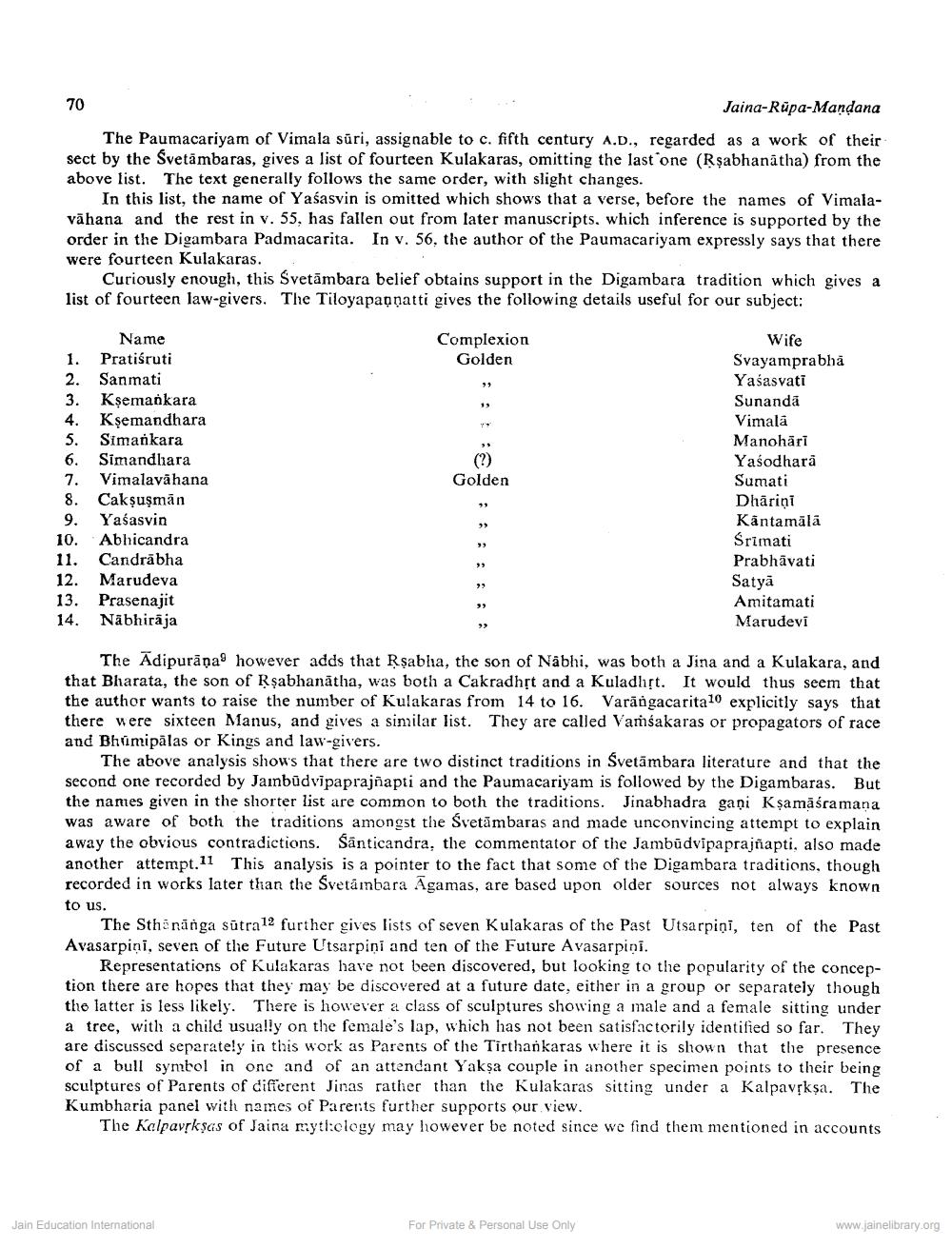________________
Jaina-Rupa-Mandana
The Paumacariyam of Vimala sūri, assignable to c. fifth century A.D., regarded as a work of their sect by the Svetämbaras, gives a list of fourteen Kulakaras, omitting the last one (Rşabhanātha) from the above list. The text generally follows the same order, with slight changes.
In this list, the name of Yaśasvin is omitted which shows that a verse, before the names of Vimalavāhana and the rest in v. 55, has fallen out from fater manuscripts, which inference is supported by the order in the Digambara Padmacarita. In v. 56, the author of the Paumacariyam expressly says that there were fourteen Kulakaras.
Curiously enough, this Svetāmbara belief obtains support in the Digambara tradition which gives a list of fourteen law-givers. The Tiloyapannatti gives the following details useful for our subject:
Complexion
Golden
Name 1. Pratiśruti
Sanmati
Kșemankara 4. Kşemandhara
Simankara
Simandhara 7. Vimalavāhana
Cakşuşmān
Yaśasvin 10. Abhicandra
Candrābha Marudeva
Prasenajit 14. Nābhiraja
(?) Golden
Wife Svayamprabha Yasasvati Sunanda Vimala Manohāri Yasodhara Sumati Dhārini Kantamālā Srimati Prabhāvati Satya Amitamati Marudevi
13.
The Adipurāna however adds that Rşabha, the son of Nābhi, was both a Jina and a Kulakara, and that Bharata, the son of Rşabhanātha, was both a Cakradhrt and a Kuladhst. It would thus seem that the author wants to raise the number of Kulakaras from 14 to 16. Varängacarita10 explicitly says that there were sixteen Manus, and gives a similar list. They are called Vamsakaras or propagators of race and Bhumipālas or Kings and law-givers.
The above analysis show's that there are two distinct traditions in Svetämbara literature and that the second one recorded by Jainbūdvipaprajnapti and the Paumacariyam is followed by the Digambaras. But the names given in the shorter list are common to both the traditions. Jinabhadra gani kşamāśramana was aware of both the traditions amongst the Svetämbaras and made unconvincing attempt to explain away the obvious contradictions. Sänticandra, the commentator of the Jambūdvipaprajñapti, also made another attempt.11 This analysis is a pointer to the fact that some of the Digambara traditions, though recorded in works later than the Svetainbara Agamas, are based upon older sources not always known to us.
The Sthi nănga sūtra 12 further gives lists of seven Kulakaras of the Past Utsarpini, ten of the Past Avasarpini, seven of the Future Utsarpini and ten of the Future Avasarpini.
Representations of Kulakaras have not been discovered, but looking to the popularity of the conception there are hopes that they may be discovered at a future date, either in a group or separately though the latter is less likely. There is however a class of sculptures showing a male and a female sitting under a tree, with a child usually on the female's lap, which has not been satisfactorily identified so far. They are discussed separately in this work as Parents of the Tirthankaras where it is shown that the presence of a bull symbol in one and of an attendant Yakşa couple in another specimen points to their being sculptures of Parents of different Jinas rather than the Kulakaras sitting under a Kalpavskșa. The Kumbharia panel with names of Parents further supports our view.
The Kelpavrkşas of Jaina ryti:clogy may however be noted since we find them mentioned in accounts
Jain Education International
For Private & Personal Use Only
www.jainelibrary.org




